Analyzing Dementia: A Contemporary Issue in Health and Social Care
VerifiedAdded on 2020/12/10
|15
|5204
|268
Report
AI Summary
This report provides a detailed analysis of dementia as a contemporary issue within the health and social care sector, specifically focusing on the United Kingdom and the role of the NHS. It explores how information regarding health and social care reaches the public domain, evaluating the different channels and techniques used for dissemination, including mass media, conferences, sponsorships, and traditional media. The report then examines how the presentation of information influences public attitudes, thoughts, and behaviors. Furthermore, it delves into how media influences public attitudes towards dementia, evaluates the reliability and validity of media information, and analyzes different perspectives on dementia within the context of health and social care. The report also assesses the evolution of these perspectives over time, their relevance to local health and social care practices, and the factors influencing their development. Finally, it examines the extent to which local attitudes reflect national trends, evaluates the validity of public attitudes and behaviors, and justifies the potential consequences of contemporary thinking for health and social care provision and services. This report is a valuable resource for understanding the complexities of dementia and its impact on public health.
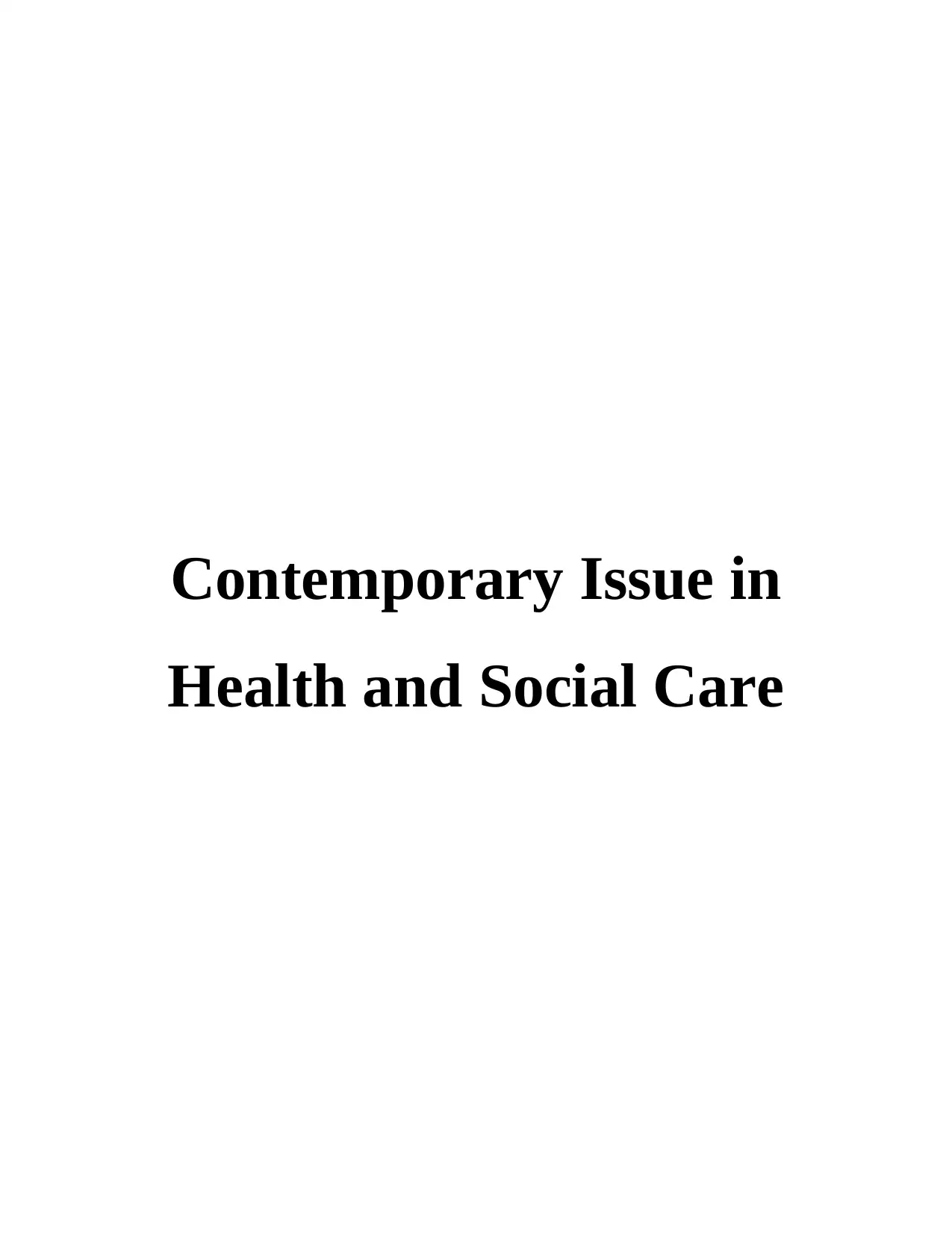
Contemporary Issue in
Health and Social Care
Health and Social Care
Paraphrase This Document
Need a fresh take? Get an instant paraphrase of this document with our AI Paraphraser
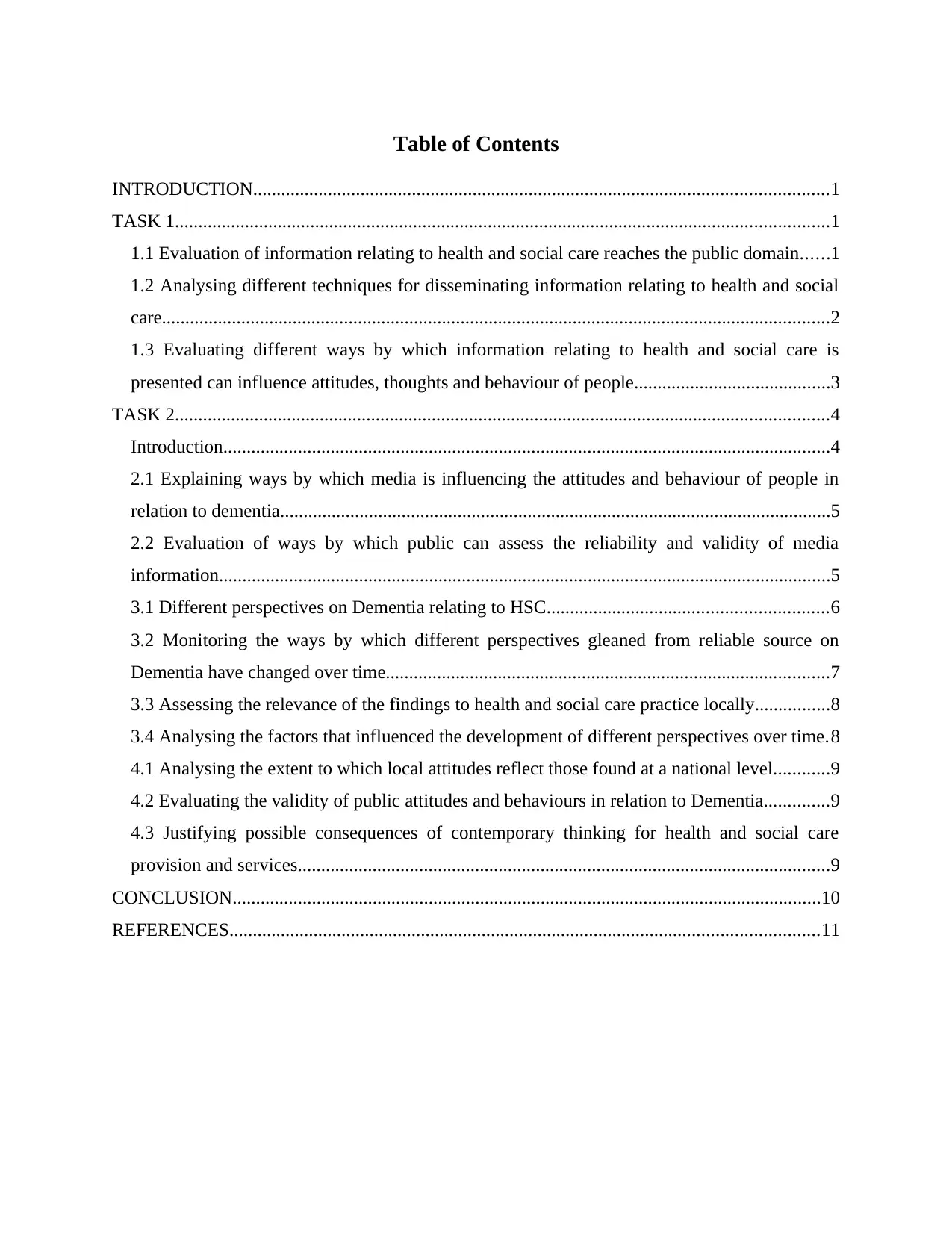
Table of Contents
INTRODUCTION...........................................................................................................................1
TASK 1............................................................................................................................................1
1.1 Evaluation of information relating to health and social care reaches the public domain......1
1.2 Analysing different techniques for disseminating information relating to health and social
care...............................................................................................................................................2
1.3 Evaluating different ways by which information relating to health and social care is
presented can influence attitudes, thoughts and behaviour of people..........................................3
TASK 2............................................................................................................................................4
Introduction..................................................................................................................................4
2.1 Explaining ways by which media is influencing the attitudes and behaviour of people in
relation to dementia......................................................................................................................5
2.2 Evaluation of ways by which public can assess the reliability and validity of media
information...................................................................................................................................5
3.1 Different perspectives on Dementia relating to HSC............................................................6
3.2 Monitoring the ways by which different perspectives gleaned from reliable source on
Dementia have changed over time...............................................................................................7
3.3 Assessing the relevance of the findings to health and social care practice locally................8
3.4 Analysing the factors that influenced the development of different perspectives over time.8
4.1 Analysing the extent to which local attitudes reflect those found at a national level............9
4.2 Evaluating the validity of public attitudes and behaviours in relation to Dementia..............9
4.3 Justifying possible consequences of contemporary thinking for health and social care
provision and services..................................................................................................................9
CONCLUSION..............................................................................................................................10
REFERENCES..............................................................................................................................11
INTRODUCTION...........................................................................................................................1
TASK 1............................................................................................................................................1
1.1 Evaluation of information relating to health and social care reaches the public domain......1
1.2 Analysing different techniques for disseminating information relating to health and social
care...............................................................................................................................................2
1.3 Evaluating different ways by which information relating to health and social care is
presented can influence attitudes, thoughts and behaviour of people..........................................3
TASK 2............................................................................................................................................4
Introduction..................................................................................................................................4
2.1 Explaining ways by which media is influencing the attitudes and behaviour of people in
relation to dementia......................................................................................................................5
2.2 Evaluation of ways by which public can assess the reliability and validity of media
information...................................................................................................................................5
3.1 Different perspectives on Dementia relating to HSC............................................................6
3.2 Monitoring the ways by which different perspectives gleaned from reliable source on
Dementia have changed over time...............................................................................................7
3.3 Assessing the relevance of the findings to health and social care practice locally................8
3.4 Analysing the factors that influenced the development of different perspectives over time.8
4.1 Analysing the extent to which local attitudes reflect those found at a national level............9
4.2 Evaluating the validity of public attitudes and behaviours in relation to Dementia..............9
4.3 Justifying possible consequences of contemporary thinking for health and social care
provision and services..................................................................................................................9
CONCLUSION..............................................................................................................................10
REFERENCES..............................................................................................................................11
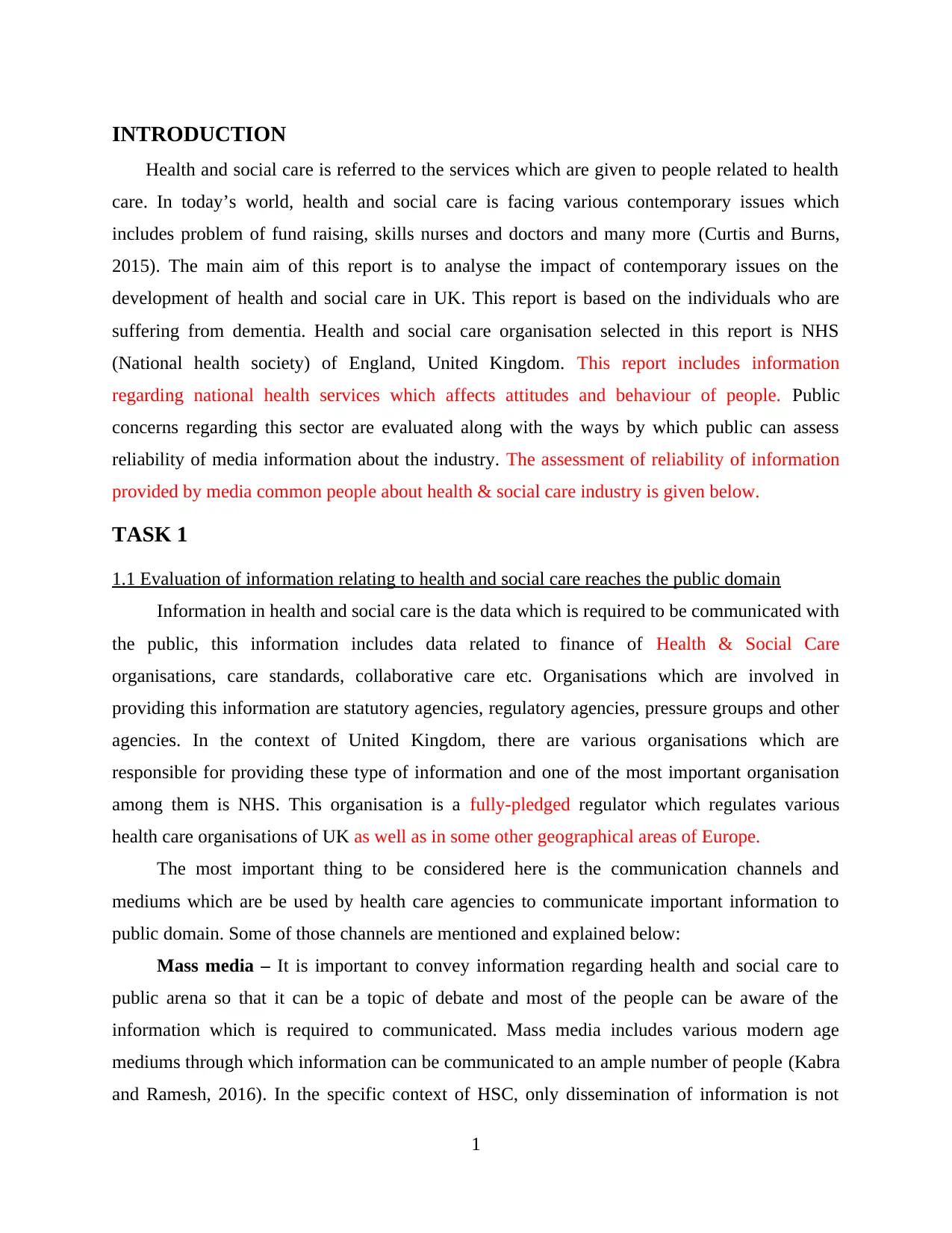
INTRODUCTION
Health and social care is referred to the services which are given to people related to health
care. In today’s world, health and social care is facing various contemporary issues which
includes problem of fund raising, skills nurses and doctors and many more (Curtis and Burns,
2015). The main aim of this report is to analyse the impact of contemporary issues on the
development of health and social care in UK. This report is based on the individuals who are
suffering from dementia. Health and social care organisation selected in this report is NHS
(National health society) of England, United Kingdom. This report includes information
regarding national health services which affects attitudes and behaviour of people. Public
concerns regarding this sector are evaluated along with the ways by which public can assess
reliability of media information about the industry. The assessment of reliability of information
provided by media common people about health & social care industry is given below.
TASK 1
1.1 Evaluation of information relating to health and social care reaches the public domain
Information in health and social care is the data which is required to be communicated with
the public, this information includes data related to finance of Health & Social Care
organisations, care standards, collaborative care etc. Organisations which are involved in
providing this information are statutory agencies, regulatory agencies, pressure groups and other
agencies. In the context of United Kingdom, there are various organisations which are
responsible for providing these type of information and one of the most important organisation
among them is NHS. This organisation is a fully-pledged regulator which regulates various
health care organisations of UK as well as in some other geographical areas of Europe.
The most important thing to be considered here is the communication channels and
mediums which are be used by health care agencies to communicate important information to
public domain. Some of those channels are mentioned and explained below:
Mass media – It is important to convey information regarding health and social care to
public arena so that it can be a topic of debate and most of the people can be aware of the
information which is required to communicated. Mass media includes various modern age
mediums through which information can be communicated to an ample number of people (Kabra
and Ramesh, 2016). In the specific context of HSC, only dissemination of information is not
1
Health and social care is referred to the services which are given to people related to health
care. In today’s world, health and social care is facing various contemporary issues which
includes problem of fund raising, skills nurses and doctors and many more (Curtis and Burns,
2015). The main aim of this report is to analyse the impact of contemporary issues on the
development of health and social care in UK. This report is based on the individuals who are
suffering from dementia. Health and social care organisation selected in this report is NHS
(National health society) of England, United Kingdom. This report includes information
regarding national health services which affects attitudes and behaviour of people. Public
concerns regarding this sector are evaluated along with the ways by which public can assess
reliability of media information about the industry. The assessment of reliability of information
provided by media common people about health & social care industry is given below.
TASK 1
1.1 Evaluation of information relating to health and social care reaches the public domain
Information in health and social care is the data which is required to be communicated with
the public, this information includes data related to finance of Health & Social Care
organisations, care standards, collaborative care etc. Organisations which are involved in
providing this information are statutory agencies, regulatory agencies, pressure groups and other
agencies. In the context of United Kingdom, there are various organisations which are
responsible for providing these type of information and one of the most important organisation
among them is NHS. This organisation is a fully-pledged regulator which regulates various
health care organisations of UK as well as in some other geographical areas of Europe.
The most important thing to be considered here is the communication channels and
mediums which are be used by health care agencies to communicate important information to
public domain. Some of those channels are mentioned and explained below:
Mass media – It is important to convey information regarding health and social care to
public arena so that it can be a topic of debate and most of the people can be aware of the
information which is required to communicated. Mass media includes various modern age
mediums through which information can be communicated to an ample number of people (Kabra
and Ramesh, 2016). In the specific context of HSC, only dissemination of information is not
1
⊘ This is a preview!⊘
Do you want full access?
Subscribe today to unlock all pages.

Trusted by 1+ million students worldwide
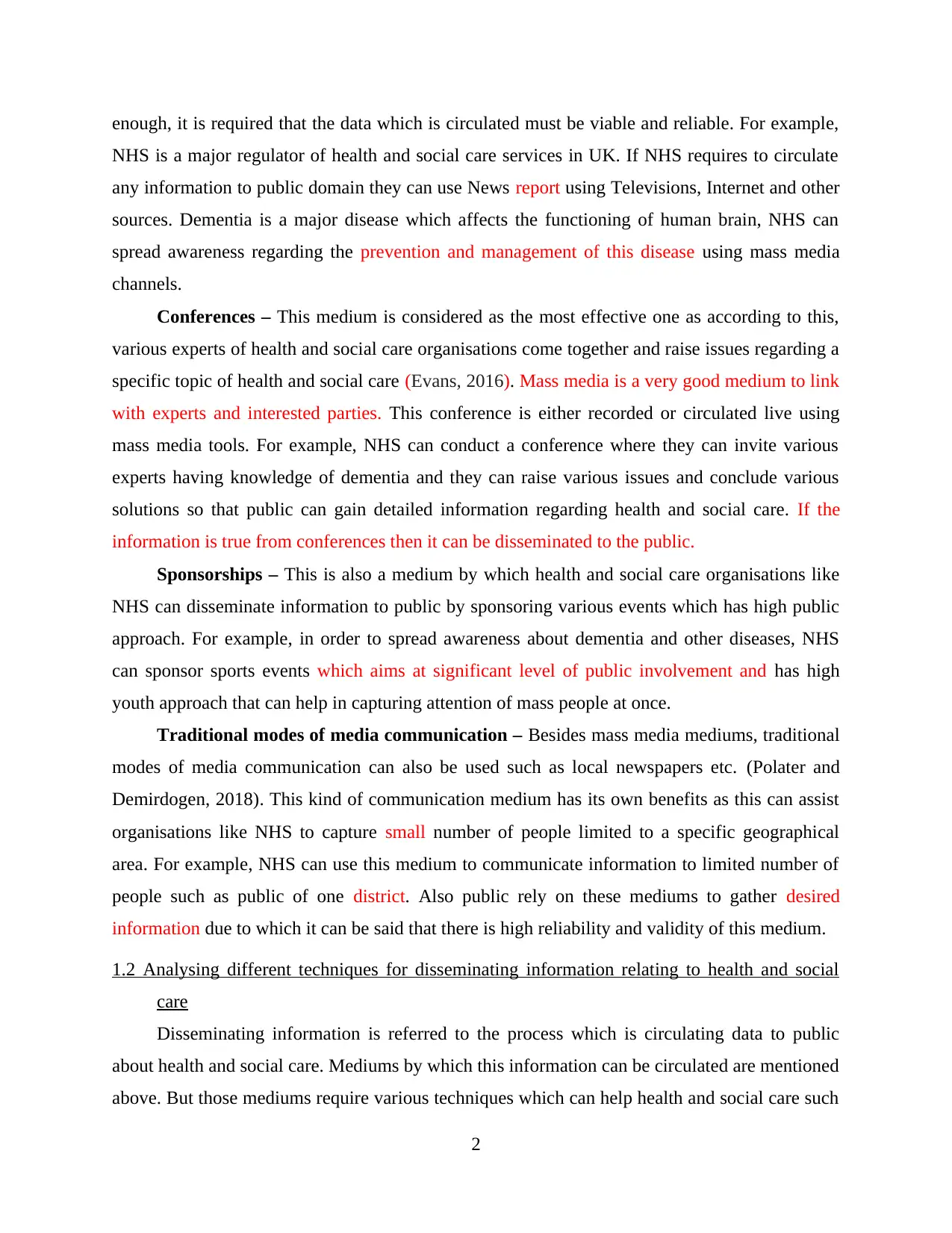
enough, it is required that the data which is circulated must be viable and reliable. For example,
NHS is a major regulator of health and social care services in UK. If NHS requires to circulate
any information to public domain they can use News report using Televisions, Internet and other
sources. Dementia is a major disease which affects the functioning of human brain, NHS can
spread awareness regarding the prevention and management of this disease using mass media
channels.
Conferences – This medium is considered as the most effective one as according to this,
various experts of health and social care organisations come together and raise issues regarding a
specific topic of health and social care (Evans, 2016). Mass media is a very good medium to link
with experts and interested parties. This conference is either recorded or circulated live using
mass media tools. For example, NHS can conduct a conference where they can invite various
experts having knowledge of dementia and they can raise various issues and conclude various
solutions so that public can gain detailed information regarding health and social care. If the
information is true from conferences then it can be disseminated to the public.
Sponsorships – This is also a medium by which health and social care organisations like
NHS can disseminate information to public by sponsoring various events which has high public
approach. For example, in order to spread awareness about dementia and other diseases, NHS
can sponsor sports events which aims at significant level of public involvement and has high
youth approach that can help in capturing attention of mass people at once.
Traditional modes of media communication – Besides mass media mediums, traditional
modes of media communication can also be used such as local newspapers etc. (Polater and
Demirdogen, 2018). This kind of communication medium has its own benefits as this can assist
organisations like NHS to capture small number of people limited to a specific geographical
area. For example, NHS can use this medium to communicate information to limited number of
people such as public of one district. Also public rely on these mediums to gather desired
information due to which it can be said that there is high reliability and validity of this medium.
1.2 Analysing different techniques for disseminating information relating to health and social
care
Disseminating information is referred to the process which is circulating data to public
about health and social care. Mediums by which this information can be circulated are mentioned
above. But those mediums require various techniques which can help health and social care such
2
NHS is a major regulator of health and social care services in UK. If NHS requires to circulate
any information to public domain they can use News report using Televisions, Internet and other
sources. Dementia is a major disease which affects the functioning of human brain, NHS can
spread awareness regarding the prevention and management of this disease using mass media
channels.
Conferences – This medium is considered as the most effective one as according to this,
various experts of health and social care organisations come together and raise issues regarding a
specific topic of health and social care (Evans, 2016). Mass media is a very good medium to link
with experts and interested parties. This conference is either recorded or circulated live using
mass media tools. For example, NHS can conduct a conference where they can invite various
experts having knowledge of dementia and they can raise various issues and conclude various
solutions so that public can gain detailed information regarding health and social care. If the
information is true from conferences then it can be disseminated to the public.
Sponsorships – This is also a medium by which health and social care organisations like
NHS can disseminate information to public by sponsoring various events which has high public
approach. For example, in order to spread awareness about dementia and other diseases, NHS
can sponsor sports events which aims at significant level of public involvement and has high
youth approach that can help in capturing attention of mass people at once.
Traditional modes of media communication – Besides mass media mediums, traditional
modes of media communication can also be used such as local newspapers etc. (Polater and
Demirdogen, 2018). This kind of communication medium has its own benefits as this can assist
organisations like NHS to capture small number of people limited to a specific geographical
area. For example, NHS can use this medium to communicate information to limited number of
people such as public of one district. Also public rely on these mediums to gather desired
information due to which it can be said that there is high reliability and validity of this medium.
1.2 Analysing different techniques for disseminating information relating to health and social
care
Disseminating information is referred to the process which is circulating data to public
about health and social care. Mediums by which this information can be circulated are mentioned
above. But those mediums require various techniques which can help health and social care such
2
Paraphrase This Document
Need a fresh take? Get an instant paraphrase of this document with our AI Paraphraser
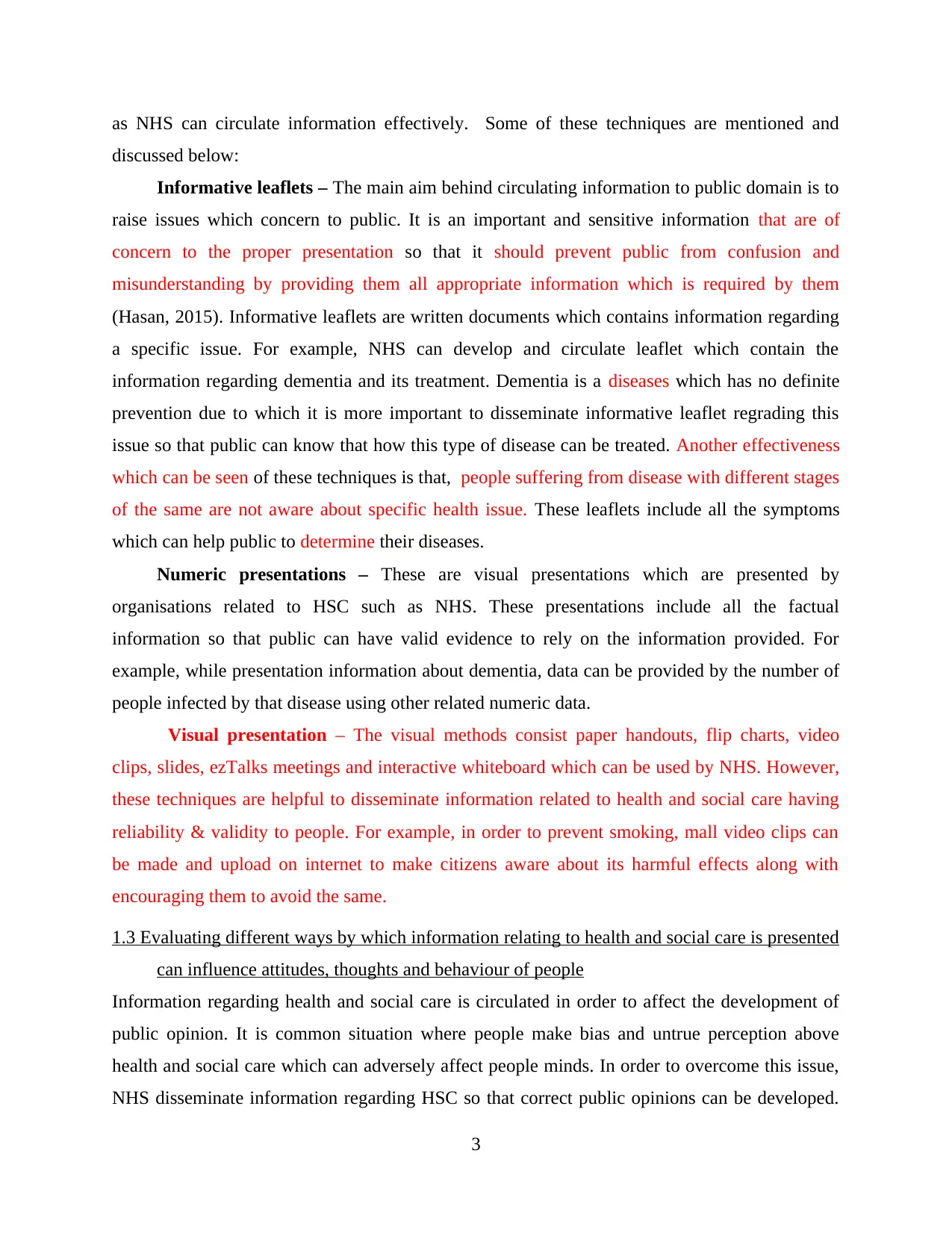
as NHS can circulate information effectively. Some of these techniques are mentioned and
discussed below:
Informative leaflets – The main aim behind circulating information to public domain is to
raise issues which concern to public. It is an important and sensitive information that are of
concern to the proper presentation so that it should prevent public from confusion and
misunderstanding by providing them all appropriate information which is required by them
(Hasan, 2015). Informative leaflets are written documents which contains information regarding
a specific issue. For example, NHS can develop and circulate leaflet which contain the
information regarding dementia and its treatment. Dementia is a diseases which has no definite
prevention due to which it is more important to disseminate informative leaflet regrading this
issue so that public can know that how this type of disease can be treated. Another effectiveness
which can be seen of these techniques is that, people suffering from disease with different stages
of the same are not aware about specific health issue. These leaflets include all the symptoms
which can help public to determine their diseases.
Numeric presentations – These are visual presentations which are presented by
organisations related to HSC such as NHS. These presentations include all the factual
information so that public can have valid evidence to rely on the information provided. For
example, while presentation information about dementia, data can be provided by the number of
people infected by that disease using other related numeric data.
Visual presentation – The visual methods consist paper handouts, flip charts, video
clips, slides, ezTalks meetings and interactive whiteboard which can be used by NHS. However,
these techniques are helpful to disseminate information related to health and social care having
reliability & validity to people. For example, in order to prevent smoking, mall video clips can
be made and upload on internet to make citizens aware about its harmful effects along with
encouraging them to avoid the same.
1.3 Evaluating different ways by which information relating to health and social care is presented
can influence attitudes, thoughts and behaviour of people
Information regarding health and social care is circulated in order to affect the development of
public opinion. It is common situation where people make bias and untrue perception above
health and social care which can adversely affect people minds. In order to overcome this issue,
NHS disseminate information regarding HSC so that correct public opinions can be developed.
3
discussed below:
Informative leaflets – The main aim behind circulating information to public domain is to
raise issues which concern to public. It is an important and sensitive information that are of
concern to the proper presentation so that it should prevent public from confusion and
misunderstanding by providing them all appropriate information which is required by them
(Hasan, 2015). Informative leaflets are written documents which contains information regarding
a specific issue. For example, NHS can develop and circulate leaflet which contain the
information regarding dementia and its treatment. Dementia is a diseases which has no definite
prevention due to which it is more important to disseminate informative leaflet regrading this
issue so that public can know that how this type of disease can be treated. Another effectiveness
which can be seen of these techniques is that, people suffering from disease with different stages
of the same are not aware about specific health issue. These leaflets include all the symptoms
which can help public to determine their diseases.
Numeric presentations – These are visual presentations which are presented by
organisations related to HSC such as NHS. These presentations include all the factual
information so that public can have valid evidence to rely on the information provided. For
example, while presentation information about dementia, data can be provided by the number of
people infected by that disease using other related numeric data.
Visual presentation – The visual methods consist paper handouts, flip charts, video
clips, slides, ezTalks meetings and interactive whiteboard which can be used by NHS. However,
these techniques are helpful to disseminate information related to health and social care having
reliability & validity to people. For example, in order to prevent smoking, mall video clips can
be made and upload on internet to make citizens aware about its harmful effects along with
encouraging them to avoid the same.
1.3 Evaluating different ways by which information relating to health and social care is presented
can influence attitudes, thoughts and behaviour of people
Information regarding health and social care is circulated in order to affect the development of
public opinion. It is common situation where people make bias and untrue perception above
health and social care which can adversely affect people minds. In order to overcome this issue,
NHS disseminate information regarding HSC so that correct public opinions can be developed.
3
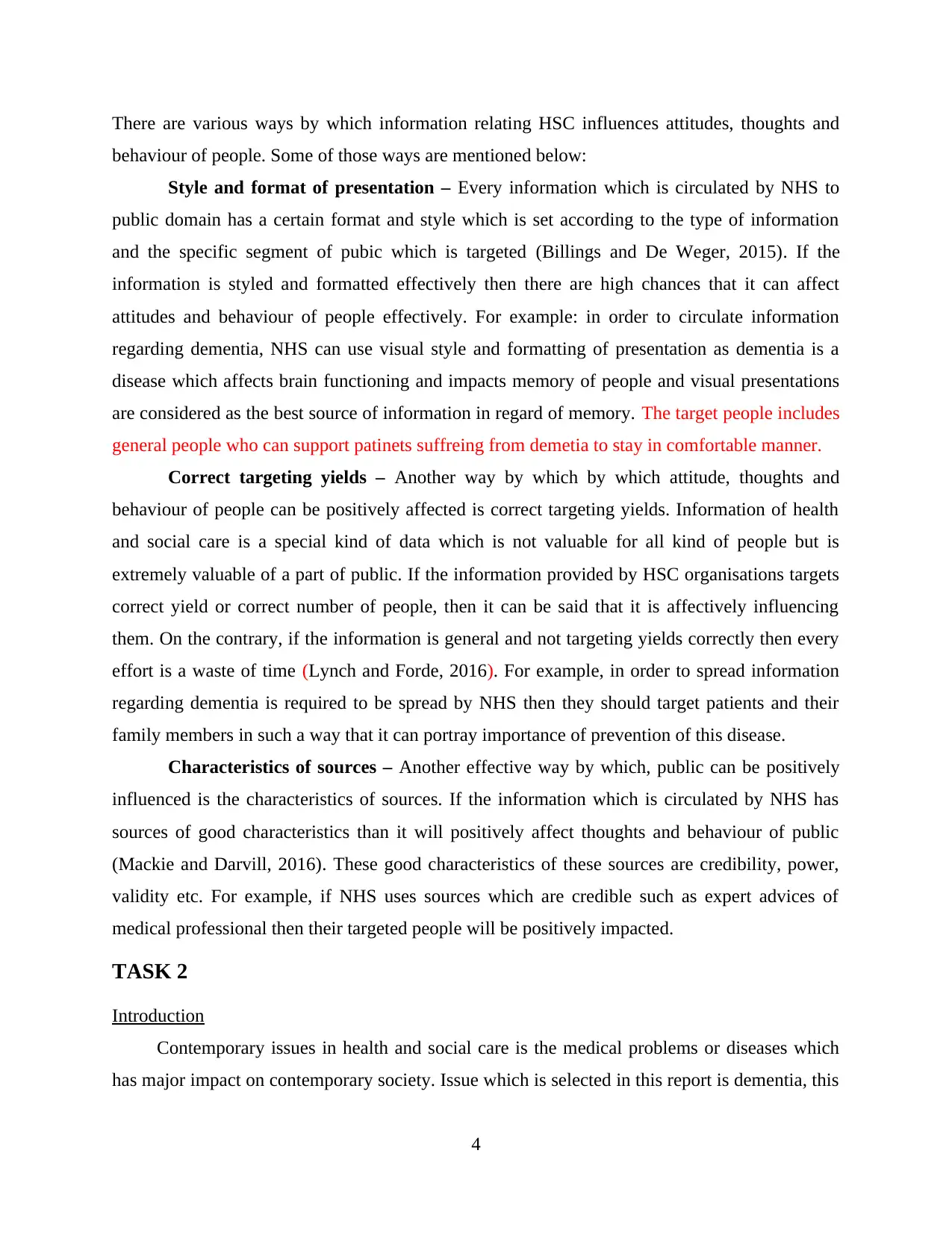
There are various ways by which information relating HSC influences attitudes, thoughts and
behaviour of people. Some of those ways are mentioned below:
Style and format of presentation – Every information which is circulated by NHS to
public domain has a certain format and style which is set according to the type of information
and the specific segment of pubic which is targeted (Billings and De Weger, 2015). If the
information is styled and formatted effectively then there are high chances that it can affect
attitudes and behaviour of people effectively. For example: in order to circulate information
regarding dementia, NHS can use visual style and formatting of presentation as dementia is a
disease which affects brain functioning and impacts memory of people and visual presentations
are considered as the best source of information in regard of memory. The target people includes
general people who can support patinets suffreing from demetia to stay in comfortable manner.
Correct targeting yields – Another way by which by which attitude, thoughts and
behaviour of people can be positively affected is correct targeting yields. Information of health
and social care is a special kind of data which is not valuable for all kind of people but is
extremely valuable of a part of public. If the information provided by HSC organisations targets
correct yield or correct number of people, then it can be said that it is affectively influencing
them. On the contrary, if the information is general and not targeting yields correctly then every
effort is a waste of time (Lynch and Forde, 2016). For example, in order to spread information
regarding dementia is required to be spread by NHS then they should target patients and their
family members in such a way that it can portray importance of prevention of this disease.
Characteristics of sources – Another effective way by which, public can be positively
influenced is the characteristics of sources. If the information which is circulated by NHS has
sources of good characteristics than it will positively affect thoughts and behaviour of public
(Mackie and Darvill, 2016). These good characteristics of these sources are credibility, power,
validity etc. For example, if NHS uses sources which are credible such as expert advices of
medical professional then their targeted people will be positively impacted.
TASK 2
Introduction
Contemporary issues in health and social care is the medical problems or diseases which
has major impact on contemporary society. Issue which is selected in this report is dementia, this
4
behaviour of people. Some of those ways are mentioned below:
Style and format of presentation – Every information which is circulated by NHS to
public domain has a certain format and style which is set according to the type of information
and the specific segment of pubic which is targeted (Billings and De Weger, 2015). If the
information is styled and formatted effectively then there are high chances that it can affect
attitudes and behaviour of people effectively. For example: in order to circulate information
regarding dementia, NHS can use visual style and formatting of presentation as dementia is a
disease which affects brain functioning and impacts memory of people and visual presentations
are considered as the best source of information in regard of memory. The target people includes
general people who can support patinets suffreing from demetia to stay in comfortable manner.
Correct targeting yields – Another way by which by which attitude, thoughts and
behaviour of people can be positively affected is correct targeting yields. Information of health
and social care is a special kind of data which is not valuable for all kind of people but is
extremely valuable of a part of public. If the information provided by HSC organisations targets
correct yield or correct number of people, then it can be said that it is affectively influencing
them. On the contrary, if the information is general and not targeting yields correctly then every
effort is a waste of time (Lynch and Forde, 2016). For example, in order to spread information
regarding dementia is required to be spread by NHS then they should target patients and their
family members in such a way that it can portray importance of prevention of this disease.
Characteristics of sources – Another effective way by which, public can be positively
influenced is the characteristics of sources. If the information which is circulated by NHS has
sources of good characteristics than it will positively affect thoughts and behaviour of public
(Mackie and Darvill, 2016). These good characteristics of these sources are credibility, power,
validity etc. For example, if NHS uses sources which are credible such as expert advices of
medical professional then their targeted people will be positively impacted.
TASK 2
Introduction
Contemporary issues in health and social care is the medical problems or diseases which
has major impact on contemporary society. Issue which is selected in this report is dementia, this
4
⊘ This is a preview!⊘
Do you want full access?
Subscribe today to unlock all pages.

Trusted by 1+ million students worldwide
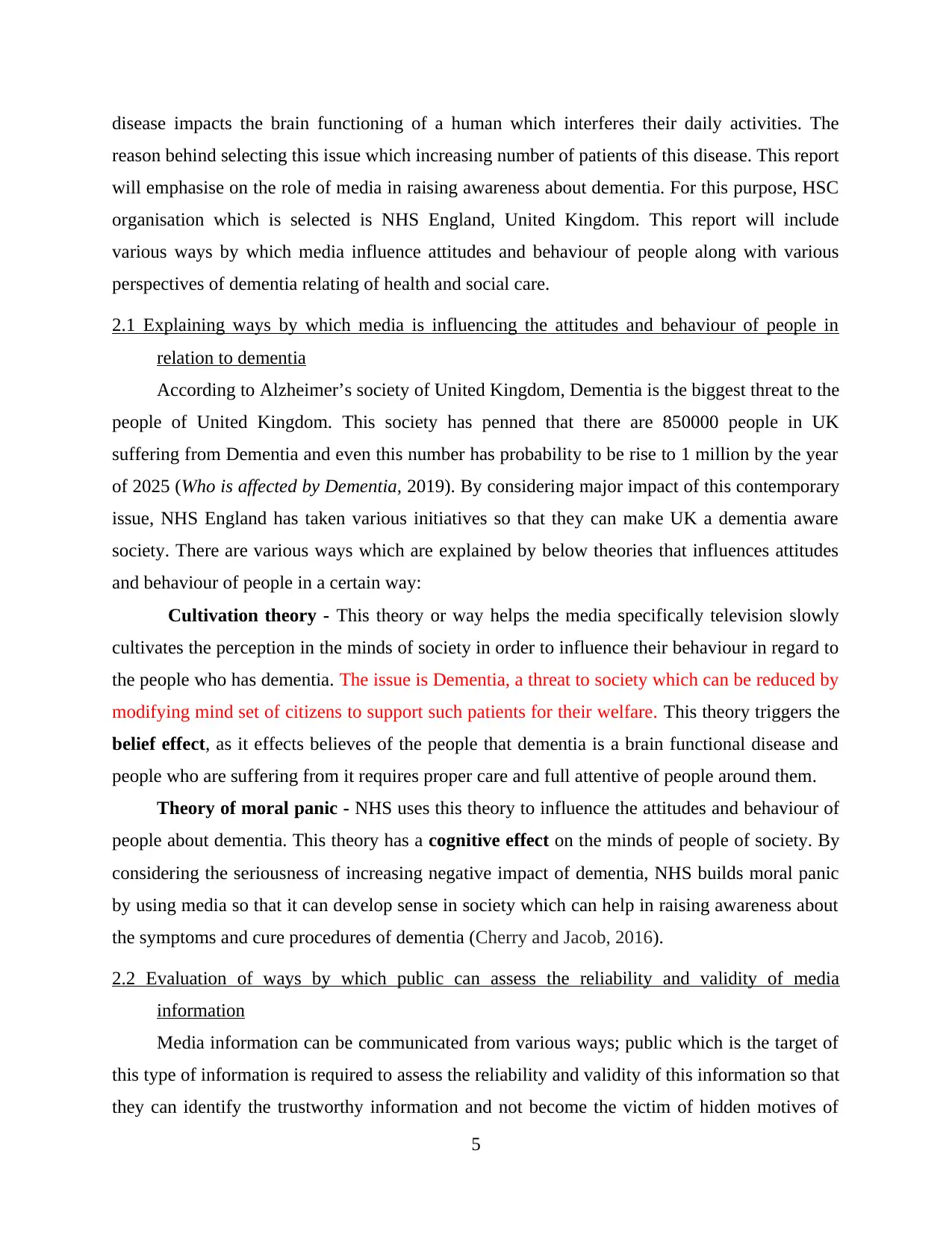
disease impacts the brain functioning of a human which interferes their daily activities. The
reason behind selecting this issue which increasing number of patients of this disease. This report
will emphasise on the role of media in raising awareness about dementia. For this purpose, HSC
organisation which is selected is NHS England, United Kingdom. This report will include
various ways by which media influence attitudes and behaviour of people along with various
perspectives of dementia relating of health and social care.
2.1 Explaining ways by which media is influencing the attitudes and behaviour of people in
relation to dementia
According to Alzheimer’s society of United Kingdom, Dementia is the biggest threat to the
people of United Kingdom. This society has penned that there are 850000 people in UK
suffering from Dementia and even this number has probability to be rise to 1 million by the year
of 2025 (Who is affected by Dementia, 2019). By considering major impact of this contemporary
issue, NHS England has taken various initiatives so that they can make UK a dementia aware
society. There are various ways which are explained by below theories that influences attitudes
and behaviour of people in a certain way:
Cultivation theory - This theory or way helps the media specifically television slowly
cultivates the perception in the minds of society in order to influence their behaviour in regard to
the people who has dementia. The issue is Dementia, a threat to society which can be reduced by
modifying mind set of citizens to support such patients for their welfare. This theory triggers the
belief effect, as it effects believes of the people that dementia is a brain functional disease and
people who are suffering from it requires proper care and full attentive of people around them.
Theory of moral panic - NHS uses this theory to influence the attitudes and behaviour of
people about dementia. This theory has a cognitive effect on the minds of people of society. By
considering the seriousness of increasing negative impact of dementia, NHS builds moral panic
by using media so that it can develop sense in society which can help in raising awareness about
the symptoms and cure procedures of dementia (Cherry and Jacob, 2016).
2.2 Evaluation of ways by which public can assess the reliability and validity of media
information
Media information can be communicated from various ways; public which is the target of
this type of information is required to assess the reliability and validity of this information so that
they can identify the trustworthy information and not become the victim of hidden motives of
5
reason behind selecting this issue which increasing number of patients of this disease. This report
will emphasise on the role of media in raising awareness about dementia. For this purpose, HSC
organisation which is selected is NHS England, United Kingdom. This report will include
various ways by which media influence attitudes and behaviour of people along with various
perspectives of dementia relating of health and social care.
2.1 Explaining ways by which media is influencing the attitudes and behaviour of people in
relation to dementia
According to Alzheimer’s society of United Kingdom, Dementia is the biggest threat to the
people of United Kingdom. This society has penned that there are 850000 people in UK
suffering from Dementia and even this number has probability to be rise to 1 million by the year
of 2025 (Who is affected by Dementia, 2019). By considering major impact of this contemporary
issue, NHS England has taken various initiatives so that they can make UK a dementia aware
society. There are various ways which are explained by below theories that influences attitudes
and behaviour of people in a certain way:
Cultivation theory - This theory or way helps the media specifically television slowly
cultivates the perception in the minds of society in order to influence their behaviour in regard to
the people who has dementia. The issue is Dementia, a threat to society which can be reduced by
modifying mind set of citizens to support such patients for their welfare. This theory triggers the
belief effect, as it effects believes of the people that dementia is a brain functional disease and
people who are suffering from it requires proper care and full attentive of people around them.
Theory of moral panic - NHS uses this theory to influence the attitudes and behaviour of
people about dementia. This theory has a cognitive effect on the minds of people of society. By
considering the seriousness of increasing negative impact of dementia, NHS builds moral panic
by using media so that it can develop sense in society which can help in raising awareness about
the symptoms and cure procedures of dementia (Cherry and Jacob, 2016).
2.2 Evaluation of ways by which public can assess the reliability and validity of media
information
Media information can be communicated from various ways; public which is the target of
this type of information is required to assess the reliability and validity of this information so that
they can identify the trustworthy information and not become the victim of hidden motives of
5
Paraphrase This Document
Need a fresh take? Get an instant paraphrase of this document with our AI Paraphraser
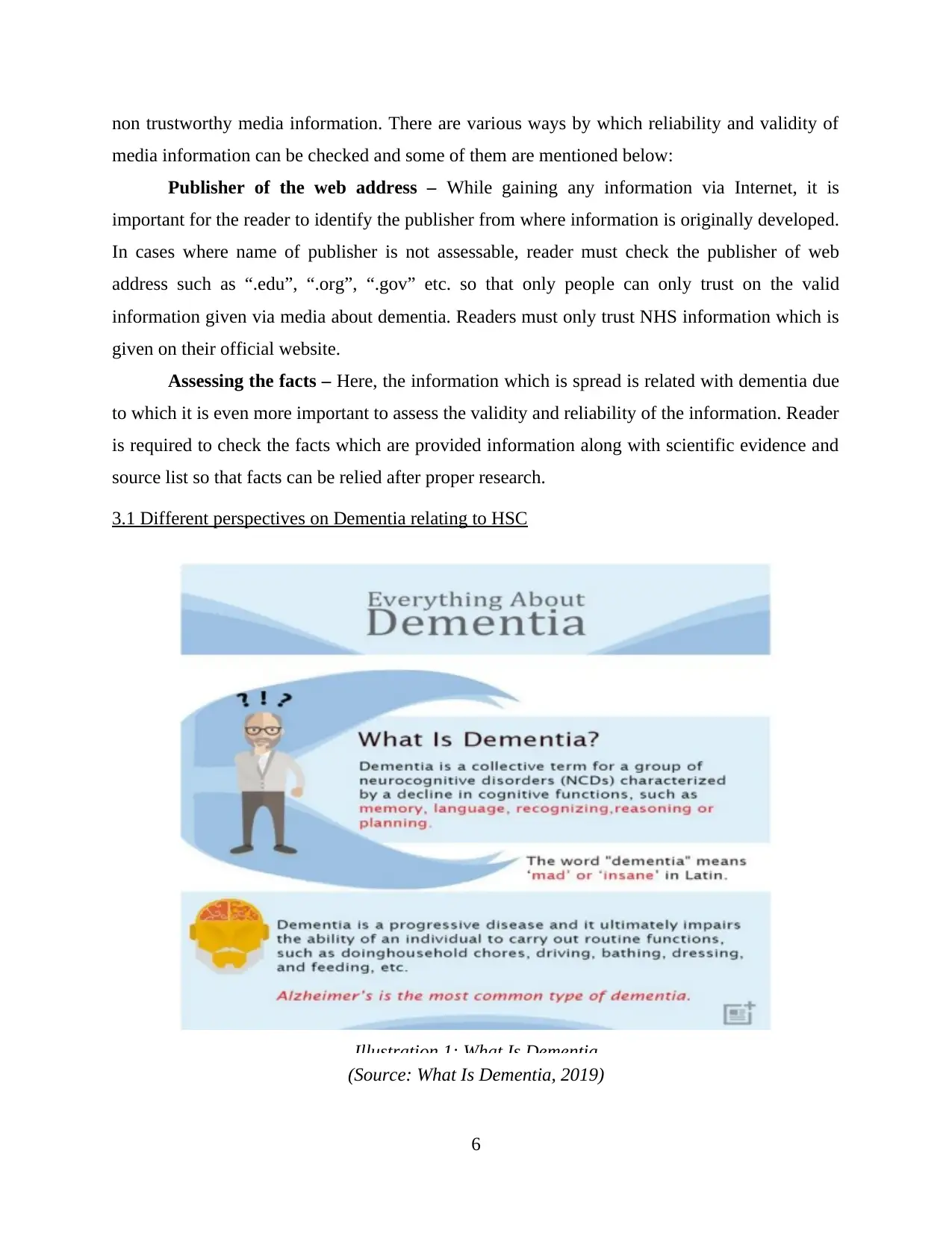
non trustworthy media information. There are various ways by which reliability and validity of
media information can be checked and some of them are mentioned below:
Publisher of the web address – While gaining any information via Internet, it is
important for the reader to identify the publisher from where information is originally developed.
In cases where name of publisher is not assessable, reader must check the publisher of web
address such as “.edu”, “.org”, “.gov” etc. so that only people can only trust on the valid
information given via media about dementia. Readers must only trust NHS information which is
given on their official website.
Assessing the facts – Here, the information which is spread is related with dementia due
to which it is even more important to assess the validity and reliability of the information. Reader
is required to check the facts which are provided information along with scientific evidence and
source list so that facts can be relied after proper research.
3.1 Different perspectives on Dementia relating to HSC
(Source: What Is Dementia, 2019)
6
Illustration 1: What Is Dementia
media information can be checked and some of them are mentioned below:
Publisher of the web address – While gaining any information via Internet, it is
important for the reader to identify the publisher from where information is originally developed.
In cases where name of publisher is not assessable, reader must check the publisher of web
address such as “.edu”, “.org”, “.gov” etc. so that only people can only trust on the valid
information given via media about dementia. Readers must only trust NHS information which is
given on their official website.
Assessing the facts – Here, the information which is spread is related with dementia due
to which it is even more important to assess the validity and reliability of the information. Reader
is required to check the facts which are provided information along with scientific evidence and
source list so that facts can be relied after proper research.
3.1 Different perspectives on Dementia relating to HSC
(Source: What Is Dementia, 2019)
6
Illustration 1: What Is Dementia
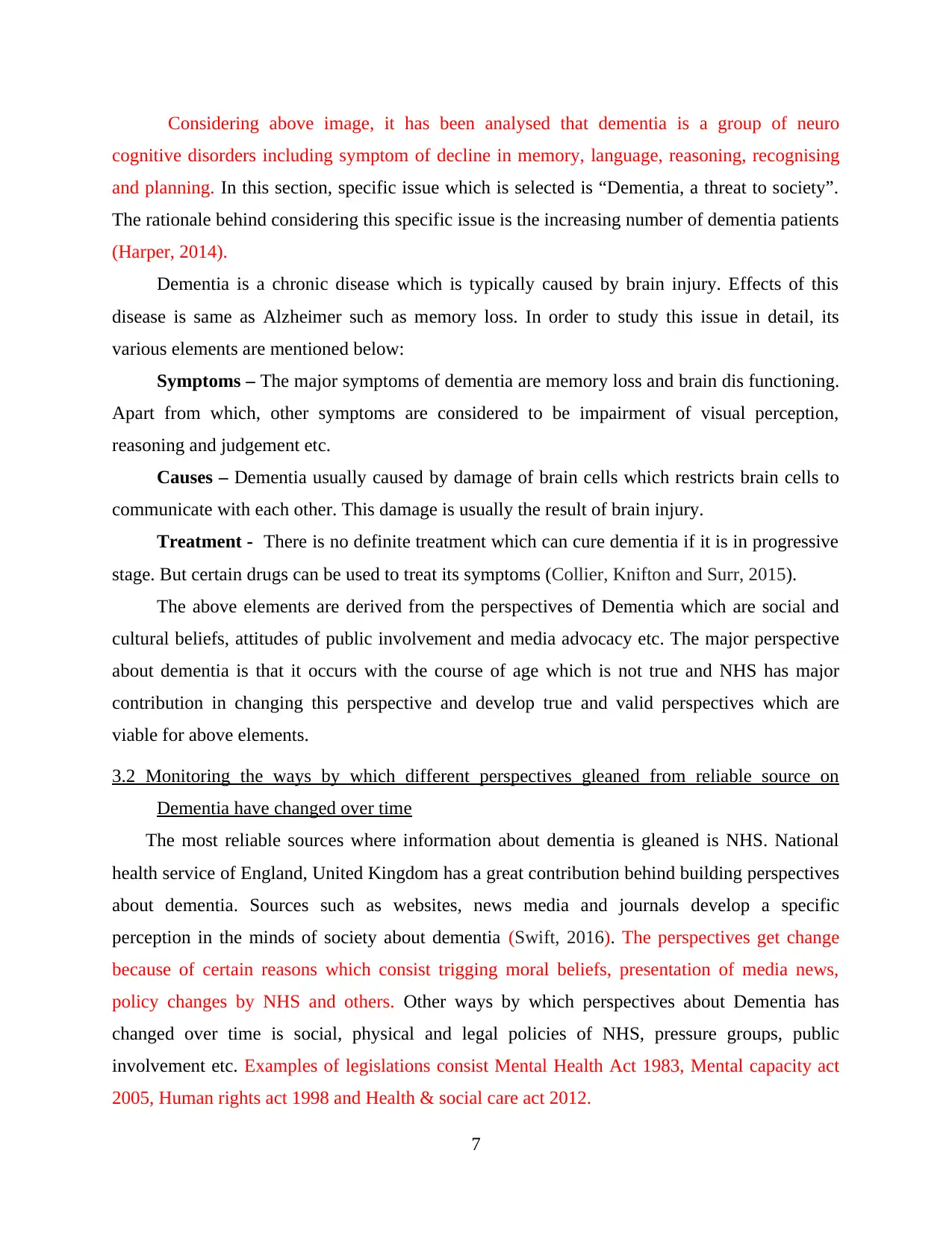
Considering above image, it has been analysed that dementia is a group of neuro
cognitive disorders including symptom of decline in memory, language, reasoning, recognising
and planning. In this section, specific issue which is selected is “Dementia, a threat to society”.
The rationale behind considering this specific issue is the increasing number of dementia patients
(Harper, 2014).
Dementia is a chronic disease which is typically caused by brain injury. Effects of this
disease is same as Alzheimer such as memory loss. In order to study this issue in detail, its
various elements are mentioned below:
Symptoms – The major symptoms of dementia are memory loss and brain dis functioning.
Apart from which, other symptoms are considered to be impairment of visual perception,
reasoning and judgement etc.
Causes – Dementia usually caused by damage of brain cells which restricts brain cells to
communicate with each other. This damage is usually the result of brain injury.
Treatment - There is no definite treatment which can cure dementia if it is in progressive
stage. But certain drugs can be used to treat its symptoms (Collier, Knifton and Surr, 2015).
The above elements are derived from the perspectives of Dementia which are social and
cultural beliefs, attitudes of public involvement and media advocacy etc. The major perspective
about dementia is that it occurs with the course of age which is not true and NHS has major
contribution in changing this perspective and develop true and valid perspectives which are
viable for above elements.
3.2 Monitoring the ways by which different perspectives gleaned from reliable source on
Dementia have changed over time
The most reliable sources where information about dementia is gleaned is NHS. National
health service of England, United Kingdom has a great contribution behind building perspectives
about dementia. Sources such as websites, news media and journals develop a specific
perception in the minds of society about dementia (Swift, 2016). The perspectives get change
because of certain reasons which consist trigging moral beliefs, presentation of media news,
policy changes by NHS and others. Other ways by which perspectives about Dementia has
changed over time is social, physical and legal policies of NHS, pressure groups, public
involvement etc. Examples of legislations consist Mental Health Act 1983, Mental capacity act
2005, Human rights act 1998 and Health & social care act 2012.
7
cognitive disorders including symptom of decline in memory, language, reasoning, recognising
and planning. In this section, specific issue which is selected is “Dementia, a threat to society”.
The rationale behind considering this specific issue is the increasing number of dementia patients
(Harper, 2014).
Dementia is a chronic disease which is typically caused by brain injury. Effects of this
disease is same as Alzheimer such as memory loss. In order to study this issue in detail, its
various elements are mentioned below:
Symptoms – The major symptoms of dementia are memory loss and brain dis functioning.
Apart from which, other symptoms are considered to be impairment of visual perception,
reasoning and judgement etc.
Causes – Dementia usually caused by damage of brain cells which restricts brain cells to
communicate with each other. This damage is usually the result of brain injury.
Treatment - There is no definite treatment which can cure dementia if it is in progressive
stage. But certain drugs can be used to treat its symptoms (Collier, Knifton and Surr, 2015).
The above elements are derived from the perspectives of Dementia which are social and
cultural beliefs, attitudes of public involvement and media advocacy etc. The major perspective
about dementia is that it occurs with the course of age which is not true and NHS has major
contribution in changing this perspective and develop true and valid perspectives which are
viable for above elements.
3.2 Monitoring the ways by which different perspectives gleaned from reliable source on
Dementia have changed over time
The most reliable sources where information about dementia is gleaned is NHS. National
health service of England, United Kingdom has a great contribution behind building perspectives
about dementia. Sources such as websites, news media and journals develop a specific
perception in the minds of society about dementia (Swift, 2016). The perspectives get change
because of certain reasons which consist trigging moral beliefs, presentation of media news,
policy changes by NHS and others. Other ways by which perspectives about Dementia has
changed over time is social, physical and legal policies of NHS, pressure groups, public
involvement etc. Examples of legislations consist Mental Health Act 1983, Mental capacity act
2005, Human rights act 1998 and Health & social care act 2012.
7
⊘ This is a preview!⊘
Do you want full access?
Subscribe today to unlock all pages.

Trusted by 1+ million students worldwide
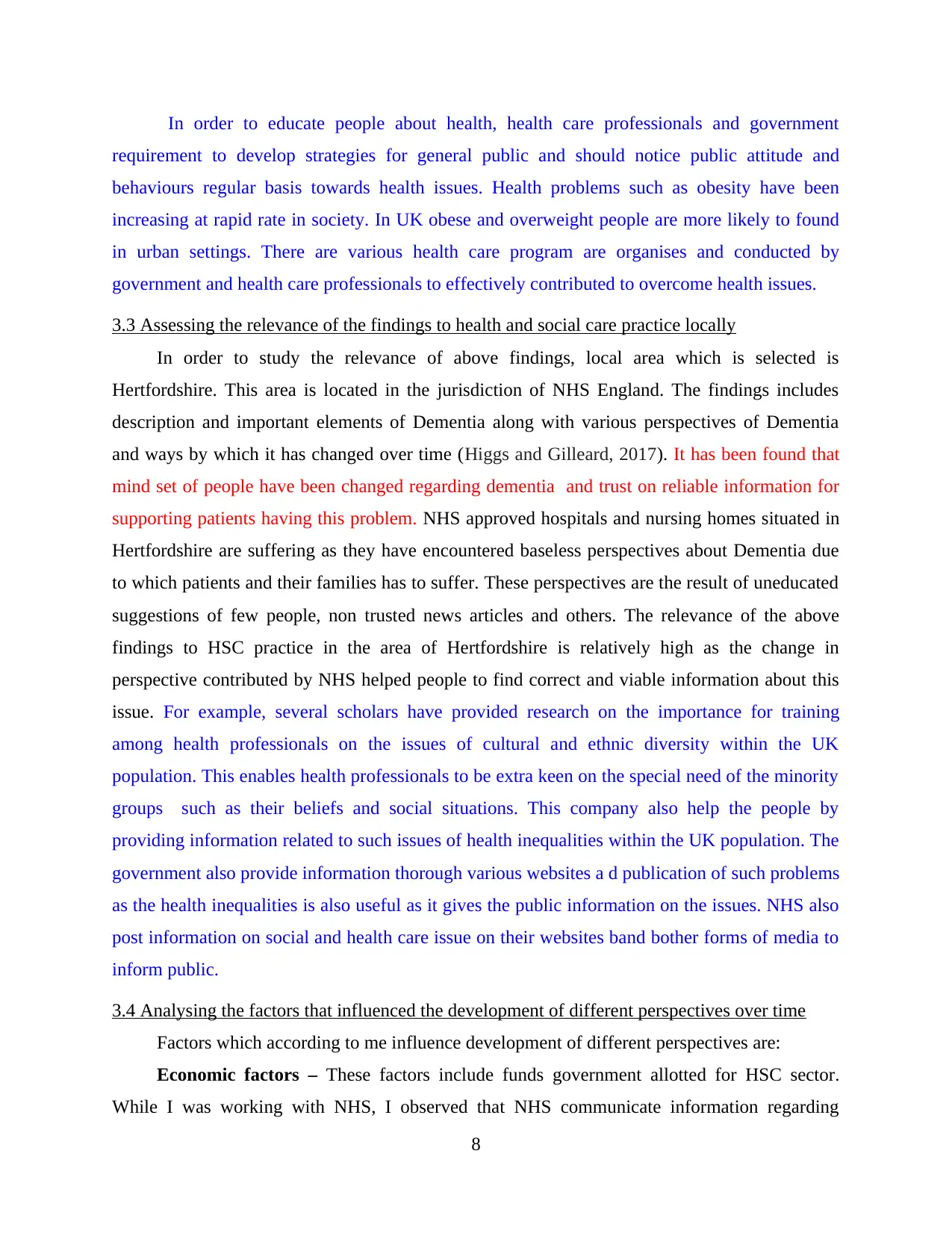
In order to educate people about health, health care professionals and government
requirement to develop strategies for general public and should notice public attitude and
behaviours regular basis towards health issues. Health problems such as obesity have been
increasing at rapid rate in society. In UK obese and overweight people are more likely to found
in urban settings. There are various health care program are organises and conducted by
government and health care professionals to effectively contributed to overcome health issues.
3.3 Assessing the relevance of the findings to health and social care practice locally
In order to study the relevance of above findings, local area which is selected is
Hertfordshire. This area is located in the jurisdiction of NHS England. The findings includes
description and important elements of Dementia along with various perspectives of Dementia
and ways by which it has changed over time (Higgs and Gilleard, 2017). It has been found that
mind set of people have been changed regarding dementia and trust on reliable information for
supporting patients having this problem. NHS approved hospitals and nursing homes situated in
Hertfordshire are suffering as they have encountered baseless perspectives about Dementia due
to which patients and their families has to suffer. These perspectives are the result of uneducated
suggestions of few people, non trusted news articles and others. The relevance of the above
findings to HSC practice in the area of Hertfordshire is relatively high as the change in
perspective contributed by NHS helped people to find correct and viable information about this
issue. For example, several scholars have provided research on the importance for training
among health professionals on the issues of cultural and ethnic diversity within the UK
population. This enables health professionals to be extra keen on the special need of the minority
groups such as their beliefs and social situations. This company also help the people by
providing information related to such issues of health inequalities within the UK population. The
government also provide information thorough various websites a d publication of such problems
as the health inequalities is also useful as it gives the public information on the issues. NHS also
post information on social and health care issue on their websites band bother forms of media to
inform public.
3.4 Analysing the factors that influenced the development of different perspectives over time
Factors which according to me influence development of different perspectives are:
Economic factors – These factors include funds government allotted for HSC sector.
While I was working with NHS, I observed that NHS communicate information regarding
8
requirement to develop strategies for general public and should notice public attitude and
behaviours regular basis towards health issues. Health problems such as obesity have been
increasing at rapid rate in society. In UK obese and overweight people are more likely to found
in urban settings. There are various health care program are organises and conducted by
government and health care professionals to effectively contributed to overcome health issues.
3.3 Assessing the relevance of the findings to health and social care practice locally
In order to study the relevance of above findings, local area which is selected is
Hertfordshire. This area is located in the jurisdiction of NHS England. The findings includes
description and important elements of Dementia along with various perspectives of Dementia
and ways by which it has changed over time (Higgs and Gilleard, 2017). It has been found that
mind set of people have been changed regarding dementia and trust on reliable information for
supporting patients having this problem. NHS approved hospitals and nursing homes situated in
Hertfordshire are suffering as they have encountered baseless perspectives about Dementia due
to which patients and their families has to suffer. These perspectives are the result of uneducated
suggestions of few people, non trusted news articles and others. The relevance of the above
findings to HSC practice in the area of Hertfordshire is relatively high as the change in
perspective contributed by NHS helped people to find correct and viable information about this
issue. For example, several scholars have provided research on the importance for training
among health professionals on the issues of cultural and ethnic diversity within the UK
population. This enables health professionals to be extra keen on the special need of the minority
groups such as their beliefs and social situations. This company also help the people by
providing information related to such issues of health inequalities within the UK population. The
government also provide information thorough various websites a d publication of such problems
as the health inequalities is also useful as it gives the public information on the issues. NHS also
post information on social and health care issue on their websites band bother forms of media to
inform public.
3.4 Analysing the factors that influenced the development of different perspectives over time
Factors which according to me influence development of different perspectives are:
Economic factors – These factors include funds government allotted for HSC sector.
While I was working with NHS, I observed that NHS communicate information regarding
8
Paraphrase This Document
Need a fresh take? Get an instant paraphrase of this document with our AI Paraphraser
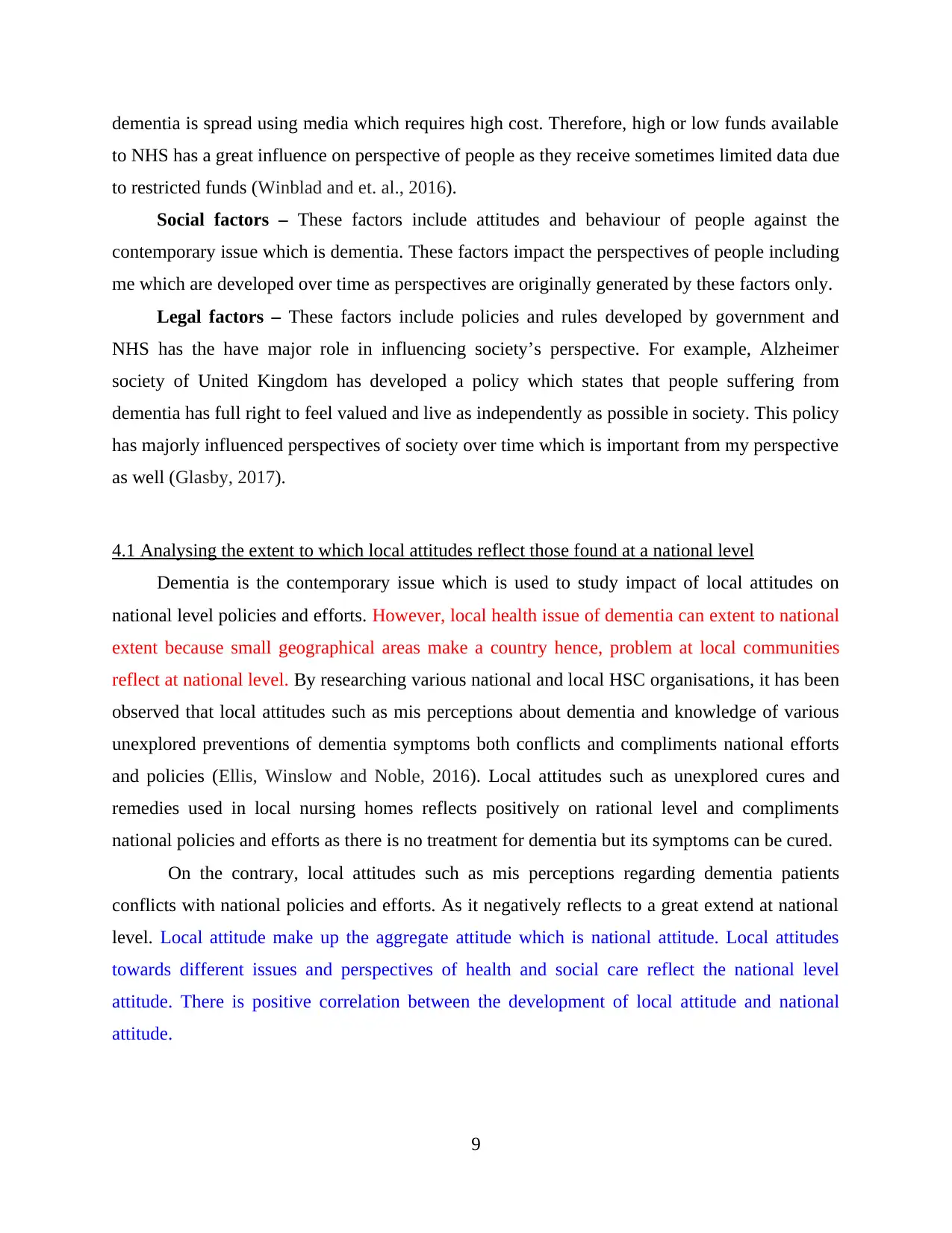
dementia is spread using media which requires high cost. Therefore, high or low funds available
to NHS has a great influence on perspective of people as they receive sometimes limited data due
to restricted funds (Winblad and et. al., 2016).
Social factors – These factors include attitudes and behaviour of people against the
contemporary issue which is dementia. These factors impact the perspectives of people including
me which are developed over time as perspectives are originally generated by these factors only.
Legal factors – These factors include policies and rules developed by government and
NHS has the have major role in influencing society’s perspective. For example, Alzheimer
society of United Kingdom has developed a policy which states that people suffering from
dementia has full right to feel valued and live as independently as possible in society. This policy
has majorly influenced perspectives of society over time which is important from my perspective
as well (Glasby, 2017).
4.1 Analysing the extent to which local attitudes reflect those found at a national level
Dementia is the contemporary issue which is used to study impact of local attitudes on
national level policies and efforts. However, local health issue of dementia can extent to national
extent because small geographical areas make a country hence, problem at local communities
reflect at national level. By researching various national and local HSC organisations, it has been
observed that local attitudes such as mis perceptions about dementia and knowledge of various
unexplored preventions of dementia symptoms both conflicts and compliments national efforts
and policies (Ellis, Winslow and Noble, 2016). Local attitudes such as unexplored cures and
remedies used in local nursing homes reflects positively on rational level and compliments
national policies and efforts as there is no treatment for dementia but its symptoms can be cured.
On the contrary, local attitudes such as mis perceptions regarding dementia patients
conflicts with national policies and efforts. As it negatively reflects to a great extend at national
level. Local attitude make up the aggregate attitude which is national attitude. Local attitudes
towards different issues and perspectives of health and social care reflect the national level
attitude. There is positive correlation between the development of local attitude and national
attitude.
9
to NHS has a great influence on perspective of people as they receive sometimes limited data due
to restricted funds (Winblad and et. al., 2016).
Social factors – These factors include attitudes and behaviour of people against the
contemporary issue which is dementia. These factors impact the perspectives of people including
me which are developed over time as perspectives are originally generated by these factors only.
Legal factors – These factors include policies and rules developed by government and
NHS has the have major role in influencing society’s perspective. For example, Alzheimer
society of United Kingdom has developed a policy which states that people suffering from
dementia has full right to feel valued and live as independently as possible in society. This policy
has majorly influenced perspectives of society over time which is important from my perspective
as well (Glasby, 2017).
4.1 Analysing the extent to which local attitudes reflect those found at a national level
Dementia is the contemporary issue which is used to study impact of local attitudes on
national level policies and efforts. However, local health issue of dementia can extent to national
extent because small geographical areas make a country hence, problem at local communities
reflect at national level. By researching various national and local HSC organisations, it has been
observed that local attitudes such as mis perceptions about dementia and knowledge of various
unexplored preventions of dementia symptoms both conflicts and compliments national efforts
and policies (Ellis, Winslow and Noble, 2016). Local attitudes such as unexplored cures and
remedies used in local nursing homes reflects positively on rational level and compliments
national policies and efforts as there is no treatment for dementia but its symptoms can be cured.
On the contrary, local attitudes such as mis perceptions regarding dementia patients
conflicts with national policies and efforts. As it negatively reflects to a great extend at national
level. Local attitude make up the aggregate attitude which is national attitude. Local attitudes
towards different issues and perspectives of health and social care reflect the national level
attitude. There is positive correlation between the development of local attitude and national
attitude.
9
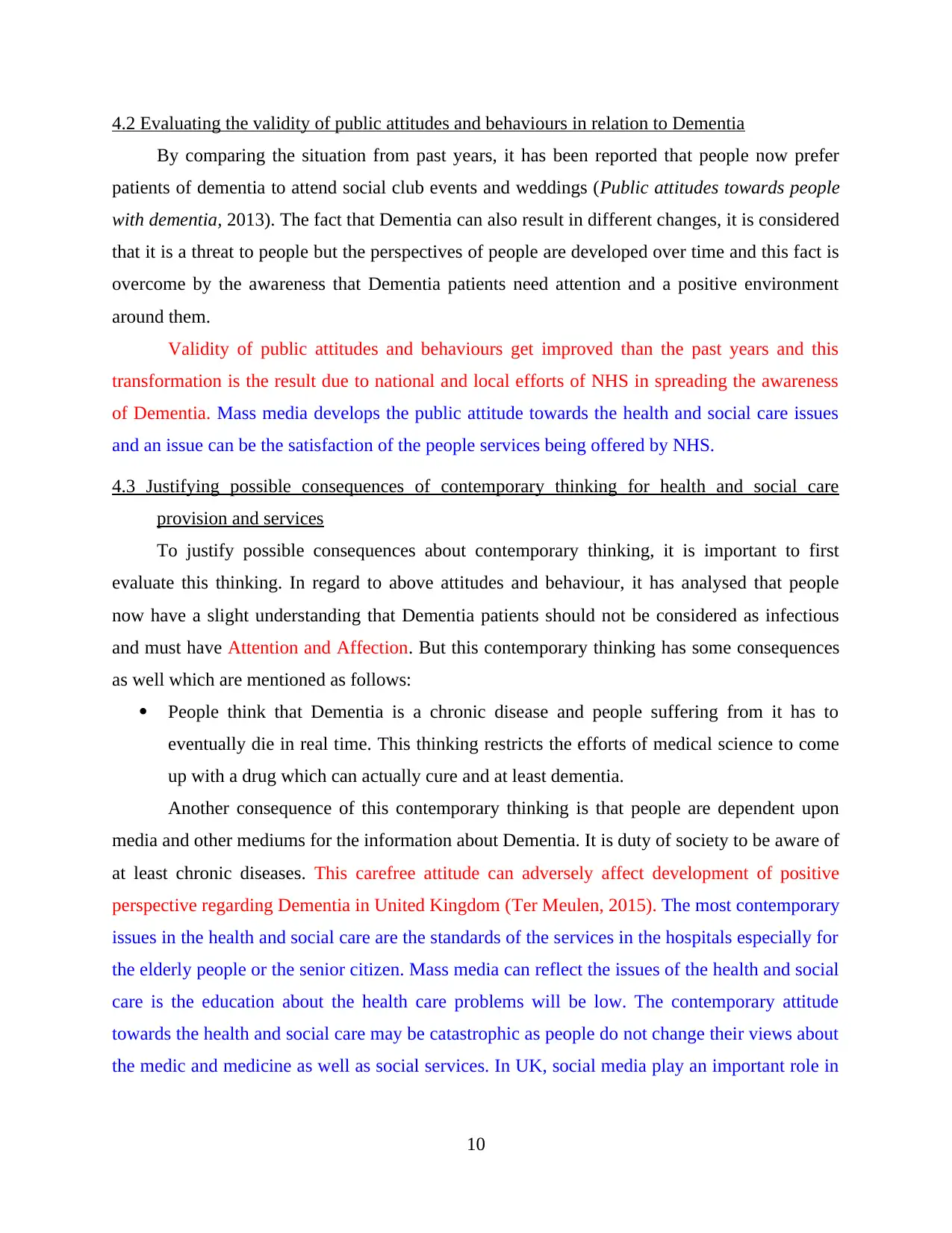
4.2 Evaluating the validity of public attitudes and behaviours in relation to Dementia
By comparing the situation from past years, it has been reported that people now prefer
patients of dementia to attend social club events and weddings (Public attitudes towards people
with dementia, 2013). The fact that Dementia can also result in different changes, it is considered
that it is a threat to people but the perspectives of people are developed over time and this fact is
overcome by the awareness that Dementia patients need attention and a positive environment
around them.
Validity of public attitudes and behaviours get improved than the past years and this
transformation is the result due to national and local efforts of NHS in spreading the awareness
of Dementia. Mass media develops the public attitude towards the health and social care issues
and an issue can be the satisfaction of the people services being offered by NHS.
4.3 Justifying possible consequences of contemporary thinking for health and social care
provision and services
To justify possible consequences about contemporary thinking, it is important to first
evaluate this thinking. In regard to above attitudes and behaviour, it has analysed that people
now have a slight understanding that Dementia patients should not be considered as infectious
and must have Attention and Affection. But this contemporary thinking has some consequences
as well which are mentioned as follows:
People think that Dementia is a chronic disease and people suffering from it has to
eventually die in real time. This thinking restricts the efforts of medical science to come
up with a drug which can actually cure and at least dementia.
Another consequence of this contemporary thinking is that people are dependent upon
media and other mediums for the information about Dementia. It is duty of society to be aware of
at least chronic diseases. This carefree attitude can adversely affect development of positive
perspective regarding Dementia in United Kingdom (Ter Meulen, 2015). The most contemporary
issues in the health and social care are the standards of the services in the hospitals especially for
the elderly people or the senior citizen. Mass media can reflect the issues of the health and social
care is the education about the health care problems will be low. The contemporary attitude
towards the health and social care may be catastrophic as people do not change their views about
the medic and medicine as well as social services. In UK, social media play an important role in
10
By comparing the situation from past years, it has been reported that people now prefer
patients of dementia to attend social club events and weddings (Public attitudes towards people
with dementia, 2013). The fact that Dementia can also result in different changes, it is considered
that it is a threat to people but the perspectives of people are developed over time and this fact is
overcome by the awareness that Dementia patients need attention and a positive environment
around them.
Validity of public attitudes and behaviours get improved than the past years and this
transformation is the result due to national and local efforts of NHS in spreading the awareness
of Dementia. Mass media develops the public attitude towards the health and social care issues
and an issue can be the satisfaction of the people services being offered by NHS.
4.3 Justifying possible consequences of contemporary thinking for health and social care
provision and services
To justify possible consequences about contemporary thinking, it is important to first
evaluate this thinking. In regard to above attitudes and behaviour, it has analysed that people
now have a slight understanding that Dementia patients should not be considered as infectious
and must have Attention and Affection. But this contemporary thinking has some consequences
as well which are mentioned as follows:
People think that Dementia is a chronic disease and people suffering from it has to
eventually die in real time. This thinking restricts the efforts of medical science to come
up with a drug which can actually cure and at least dementia.
Another consequence of this contemporary thinking is that people are dependent upon
media and other mediums for the information about Dementia. It is duty of society to be aware of
at least chronic diseases. This carefree attitude can adversely affect development of positive
perspective regarding Dementia in United Kingdom (Ter Meulen, 2015). The most contemporary
issues in the health and social care are the standards of the services in the hospitals especially for
the elderly people or the senior citizen. Mass media can reflect the issues of the health and social
care is the education about the health care problems will be low. The contemporary attitude
towards the health and social care may be catastrophic as people do not change their views about
the medic and medicine as well as social services. In UK, social media play an important role in
10
⊘ This is a preview!⊘
Do you want full access?
Subscribe today to unlock all pages.

Trusted by 1+ million students worldwide
1 out of 15
Related Documents
Your All-in-One AI-Powered Toolkit for Academic Success.
+13062052269
info@desklib.com
Available 24*7 on WhatsApp / Email
![[object Object]](/_next/static/media/star-bottom.7253800d.svg)
Unlock your academic potential
Copyright © 2020–2025 A2Z Services. All Rights Reserved. Developed and managed by ZUCOL.





